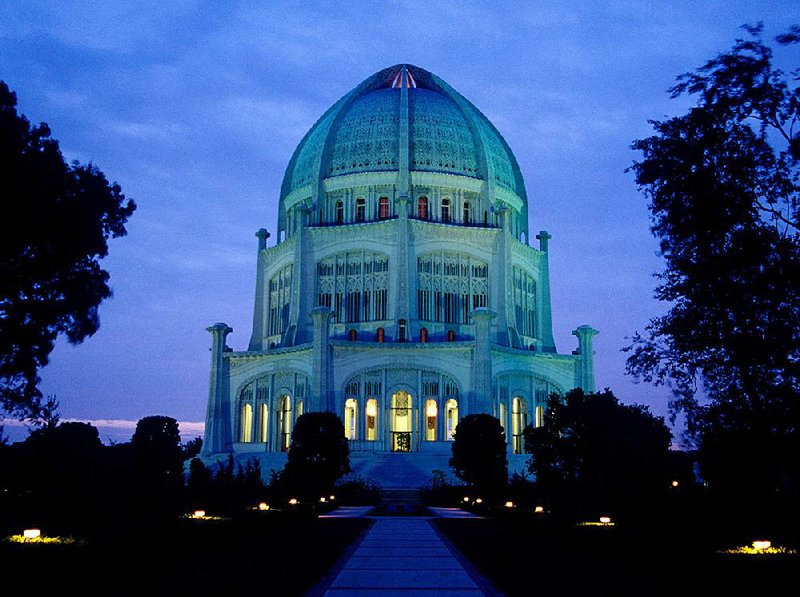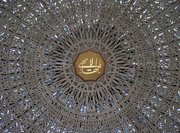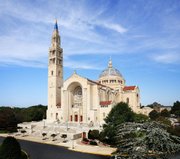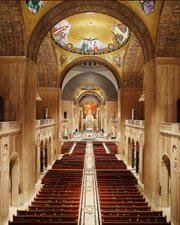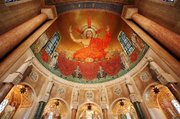Editor's note: This is the first part of a two-part series.
Arkansas is home to many architecturally beautiful churches, chapels and other houses of worship -- the award-winning Thorncrown Chapel in Eureka Springs among them -- but for those traveling farther from home this summer, here are two worth exploring.
Basilica of the National Shrine of the Immaculate Conception in Washington
As the largest Catholic church in the United States, the Basilica of the National Shrine of the Immaculate Conception is a massive presence in the nation's capital. About 1 million pilgrims and tourists visit the basilica each year.
The shrine was the idea of Bishop Thomas J. Shahan, who envisioned a grand structure like the soaring cathedrals of Europe. The cornerstone was laid in 1920, and although the basilica was completed long after his death, Shahan's dream was realized when the Byzantine-Romanesque-inspired building was finally dedicated in 1959.
One of the 10 largest churches in the world, the basilica is 459 feet long and 240 wide at the transept, which runs across to the main portion of the cruciform-shaped building and forms the arms of the cross. The main roof is 120 feet high (237 feet to the top of the Great Dome) and it's a whopping 329 feet to the top of the cross on the tower.
The large exterior dome is 108 feet across and is decorated with colorful tiles featuring five symbols, each set within a Star of David -- the fleur-de-lis, a symbol of purity and royalty; cedar of Lebanon for incorruptibility; the tower of ivory as a symbol of virginity; the star of the sea for the Hebrew name Miryam; and intertwining monograms of A and M for Ave Maria.
The basilica has more than 70 chapels and oratories, as well as the world's largest collection of ecclesiastical art. It also continues to grow with more chapels and statues as well as other alterations.
Monsignor Vito A. Buonanno, director of pilgrimages, said preparations are underway to add a mosaic to the interior of the Great Dome, known as the Trinity Dome. It is surrounded by 36 stained-glass windows but has no mosaic decoration. Once completed, the scene will feature the Holy Trinity and Mary.
The basilica doesn't function as a parish church or cathedral. It's a shrine, a sacred place of devotion for pilgrims.
There are no weddings or baptisms at the basilica as there would be in a parish church. The focus is on the sacraments of reconciliation and Eucharist for those on pilgrimage to express their devotion to Mary.
"That is done throughout the day," Buonanno said. "We hear over 36,000 confessions a year and have over seven Masses a day."
Buonanno said large groups of pilgrims numbering in the thousands come each year. Others come every other year or so, with fall being the busiest season.
Not all visitors are pilgrims. Some are tourists interested in the basilica's architecture and art.
"Besides its massive size and its beauty, I do correct people when they say this is a beautiful museum," Buonanno said. "It is a house of worship and people do pray here throughout the day."
Guided tours are available at 9, 10 and 11 a.m. Monday-Saturday, as well as at 1, 2 and 3 p.m. On Sundays, tours are available at 1:30, 2:30 and 3:30 p.m. Visitors also can tour the basilica on their own using a brochure as a guide. Audio tours are available in English, Spanish and Chinese.
For those who can't make it to the basilica the website offers virtual tours, with 360-degree views of the exterior, Great Upper Church and the Crypt Church. Photos of the chapels and oratories also can be viewed.
The basilica is at 400 Michigan Ave. N.E., Washington. Information is available online at www.nationalshrine.com or by calling (202) 526-8300.
Bahai House of Worship in Wilmette, Ill.
Situated in a suburb north of Chicago, the Bahai House of Worship was designed by Louis Bourgeois, a French-Canadian architect.
The temple, which took 50 years to build, was completed in 1953. It's one of seven continental Bahai houses of worship in the world. The others are in Kampala, Uganda; Sydney; Langenhain, Germany; Panama City; Apia, Samoa; and New Delhi. An eighth temple, in Santiago, Chile, is set to be dedicated later this year.
The Bahai faith was started in 1844 in Persia (modern-day Iran). It's a monotheistic religion with more than 5 million adherents. A core teaching is the unity of all religions and that all of humanity was created by one God. Adherents believe messengers -- from Abraham and Jesus to Buddha and Muhammad -- were all sent by God with teachings specifically suited to their time. They believe their own prophet, Bahaullah, was the latest in this line of messengers but not the last.
This belief in the unity of religions was incorporated into the design of the temple, with Bourgeois using elements found in the architecture of other religions. The lacy Arabesque panels allow light to stream in from the outside during the day, and from within when lighted at night. The house of worship also is surrounded by nine gardens and fountains.
The temple is open to all as a place of prayer, worship and peace. The temple and gardens are open 6 a.m.-10 p.m. each day, and during the summer the welcome center is open 10 a.m.-8 p.m. Devotional services are held at 9:15 a.m. and 12:30 p.m. daily, and a presentation on the Bahai faith is given at 1 p.m. Sundays, with "Fireside Conversations" for those interested in the faith at 7 p.m. each Friday.
The temple is at 100 Linden Ave., Wilmette. Information is available online at bahai.us or by calling (847) 853-2300.
Next week will highlight Utah's biggest tourist attraction, as well as a historic California cathedral.
Religion on 07/16/2016
